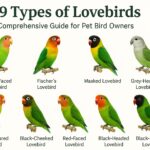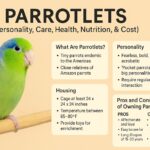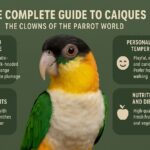Indian Ringneck Parakeets, scientifically known as Psittacula krameri, represent one of the most fascinating and widely recognized parrot species in the world. These vibrant green birds have captured the hearts of bird enthusiasts for centuries, combining striking beauty with remarkable intelligence.
Originally native to Africa and South Asia, these parakeets have established themselves as both beloved pets and successful feral populations across numerous countries. Their distinctive appearance, particularly the male’s characteristic neck ring, sets them apart from other parrot species, while their impressive vocal abilities and intelligence make them exceptional companions for experienced bird owners.
Physical Characteristics and Distinctive Features
The Indian Ringneck Parakeet presents a stunning example of avian beauty with its sleek, elongated body structure and vibrant coloration. These medium-sized parrots typically measure between 37 to 43 centimeters in length, with their impressive tails accounting for more than half of their total body length.
The tail itself can reach up to 25 centimeters long, featuring 12 distinct feathers with the two longest displaying beautiful blue coloration.
The most striking feature of these birds is their brilliant grass-green plumage that provides excellent camouflage in their natural environment. Their bodies showcase subtle blue undertones that become more noticeable during cloudy weather conditions, while their wings and tail reveal vibrant yellow feathers when spread. Each bird possesses a distinctive red or reddish beak that contrasts beautifully with their green coloration.
Sexual dimorphism becomes apparent when examining the characteristic neck markings that give these birds their common name. Adult males develop a prominent black and pink collar around their necks, featuring stunning turquoise, pink, and blue hues that create a striking visual display.
This distinctive ring typically appears when males reach sexual maturity at approximately three years of age. Female birds and immature individuals lack this distinctive collar, though some observers note a faint green ring may be visible on females.
Weight variations exist between the African and Indian subspecies, with African birds typically weighing around 105 grams and Indian subspecies weighing approximately 115 grams4. The wingspan ranges from 42 to 48 centimeters, providing these birds with excellent flight capabilities.
Natural Habitat and Global Distribution
Indian Ringneck Parakeets demonstrate remarkable adaptability in their habitat preferences, occupying an impressive range of environments across their native and introduced ranges. In their natural habitat, these birds inhabit diverse ecosystems including semi-desert regions, open scrubland, bushland, evergreen forests, light rainforests, and agricultural lands with scattered trees. Their adaptability extends to human-modified environments, where they successfully colonize gardens, orchards, towns, and cities.
The species originates from Central Africa, India, Pakistan, Sri Lanka, Nepal, and Burma, where they have thrived for thousands of years. However, their adaptability has led to successful establishment in numerous countries outside their native range.
Feral populations now exist in many countries, with particularly well-established communities in the United Kingdom, especially in London and southeastern regions. These birds have become so well-established in Britain that they now appear on the official list of British birds.
Additional introduced populations flourish in Belgium, the Netherlands, and parts of the United States, particularly in California and Florida. These feral communities primarily concentrate in urban and suburban areas where they access abundant food sources from fruit-bearing vegetation and bird feeders. The species’ remarkable adaptability allows them to survive in elevations up to 2,000 meters and across tropical, subtropical, and temperate climate zones.
Behavior and Social Structure
Indian Ringneck Parakeets exhibit complex social behaviors that reflect their high intelligence and adaptability. These birds are naturally social creatures that live in small flocks but can form much larger groups in areas where food sources are abundant. Their sedentary nature means they typically remain within established territories rather than undertaking long migrations.
Communication plays a vital role in their social structure, with these parakeets possessing three distinctive calls used for different purposes. Their most recognizable vocalization is the sharp “kee-ak” call, which differs significantly from native parrot species and helps identify their presence. These birds are notably vocal throughout the day, producing a variety of distinctive screeching calls that serve multiple communication functions.
As secondary cavity nesters, Indian Ringnecks utilize holes already excavated by other species for their nesting sites. This nesting behavior sometimes creates conflicts with native bird species competing for the same nesting locations. Their nests are typically constructed at an average height of 640 centimeters above ground and reach depths of approximately 38 centimeters to accommodate clutches of up to seven eggs.
Breeding occurs seasonally during winter months, with egg-laying taking place in February and March. Females typically lay four eggs per clutch, though the range can extend from one to seven eggs. The incubation period lasts approximately three weeks before the young hatch2.
Indian Ringnecks as Companion Birds
The history of Indian Ringnecks as companion animals spans thousands of years, with historical records indicating their introduction to Western cultures by Alexander the Great, who was reportedly impressed by their intelligence and charm. In their native India, families have traditionally kept these birds as beloved pets, appreciating their ability to bring joy to households.
These parrots possess exceptional learning abilities and talking skills that rival those of renowned talking birds such as Quaker Parakeets, African Greys, and Amazon parrots. Their capacity to learn and mimic sounds, particularly their owners’ voices, is truly extraordinary.
This remarkable vocal ability, combined with their intelligence, historically made them popular performers, with merchants training them to perform tricks such as delivering cards or pulling small wagons.
However, potential owners should carefully consider whether an Indian Ringneck suits their lifestyle and experience level. While some male Ringnecks have made excellent pets, many experts suggest there are more suitable species for individuals seeking birds that can tolerate extended periods of cage confinement. These intelligent birds easily become bored and require significant mental stimulation that may not be provided in closely confined environments.
The pair bonding behavior of Psittacula parakeets differs significantly from other parrot species, as their pair bonds are weaker and not maintained year-round. This characteristic means they are less likely to form the intensely affectionate relationships seen in species like Cockatoos, Macaws, Amazons, and African Greys. Consequently, while a Ringneck may become a very clever companion, they are less likely to develop into affectionate pets.
Health Considerations and Common Issues
Indian Ringneck Parakeets, like all pet birds, are susceptible to various health issues that require careful attention and preventive care. Understanding common health problems helps owners provide appropriate care and seek timely veterinary intervention when necessary.
Respiratory issues represent one of the most frequent health concerns affecting these birds. These problems often stem from environmental factors such as poor air quality, exposure to drafts, or contact with smoke and other airborne irritants. Symptoms may include sneezing, coughing, or nasal discharge, making it essential to maintain clean, well-ventilated environments to prevent these complications.
Digestive troubles also commonly affect Indian Ringnecks, often related to dietary issues or stress. Proper nutrition plays a crucial role in preventing many health problems, including feather plucking and various skin conditions. Regular veterinary checkups and preventive care measures are essential for maintaining optimal health in these birds.
Early recognition of illness symptoms can significantly improve treatment outcomes and prevent serious complications. Bird owners should monitor their pets closely for changes in behavior, appetite, or physical appearance that might indicate developing health issues. When serious health concerns arise, prompt veterinary care from an avian specialist is recommended to prevent complications and ensure the best possible outcomes.
The potential lifespan of Indian Ringnecks in captivity can reach approximately 40 years with proper care, making long-term health planning an important consideration for prospective owners. This extended lifespan represents a significant commitment that potential owners should carefully consider before acquiring these birds.
Frequently Asked Questions
How long do Indian Ringneck Parakeets live?
Indian Ringneck Parakeets can live approximately 40 years in captivity with proper care, making them a long-term commitment for pet owners.
When do male Indian Ringnecks develop their characteristic neck ring?
Male Indian Ringnecks typically develop their distinctive black and pink collar when they reach sexual maturity at approximately three years of age.
Are Indian Ringneck Parakeets good talkers?
Yes, Indian Ringnecks are exceptional talkers with abilities that rival Quaker Parakeets, African Greys, and Amazon parrots. They can speak clearly and are particularly skilled at mimicking their owners’ voices.
What size cage do Indian Ringnecks need?
Due to their active nature and long tails, Indian Ringnecks require spacious accommodations. They are similar in size to Quaker parrots but need additional space for their extended tail length.
Do Indian Ringnecks make affectionate pets?
Unlike some parrot species, Indian Ringnecks are less likely to form intensely affectionate bonds due to their natural pair bonding behavior, which is weaker and not maintained year-round.
What do Indian Ringnecks eat in the wild?
In their natural habitat, Indian Ringnecks feed on fruits, seeds, and vegetation. Introduced populations often rely on fruit-bearing plants and bird feeders in urban environments3.
Can Indian Ringnecks survive in cold climates?
Yes, established feral populations in countries like the United Kingdom demonstrate their ability to adapt to temperate climates, though they originated in tropical and subtropical regions6.
What are the main health concerns for Indian Ringnecks?
Common health issues include respiratory problems from poor air quality, digestive troubles often related to diet, and various skin conditions. Regular veterinary care and proper nutrition are essential for prevention.
Conclusion
Indian Ringneck Parakeets represent a remarkable species that combines natural beauty, intelligence, and adaptability in ways that continue to fascinate bird enthusiasts worldwide.
Their vibrant green plumage, distinctive neck rings in males, and impressive vocal abilities make them truly special among parrot species. While they can make rewarding companions for experienced bird owners, their specific needs and behavioral characteristics require careful consideration and commitment.
The global success of both captive and feral populations demonstrates their remarkable adaptability, though this same adaptability sometimes creates challenges in regions where they compete with native species.
For those considering these birds as companions, understanding their intelligence, social needs, and potential health concerns is essential for providing appropriate care throughout their potentially decades-long lifespans.
- 9 Types of Lovebirds (A Comprehensive Guide for Pet Bird Owners) - June 20, 2025
- Labrador Retriever: America’s Most Beloved Family Dog - June 9, 2025
- The Complete Guide to Indian Ringneck Parrots - June 9, 2025















